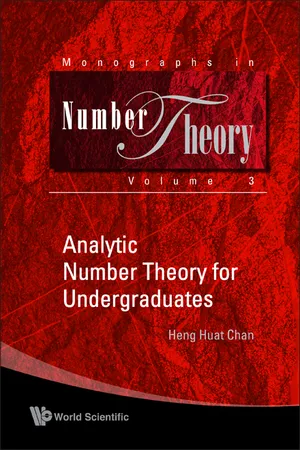
eBook - ePub
Analytic Number Theory for Undergraduates
Heng Huat Chan
This is a test
Buch teilen
- 128 Seiten
- English
- ePUB (handyfreundlich)
- Über iOS und Android verfügbar
eBook - ePub
Analytic Number Theory for Undergraduates
Heng Huat Chan
Angaben zum Buch
Buchvorschau
Inhaltsverzeichnis
Quellenangaben
Über dieses Buch
This book is written for undergraduates who wish to learn some basic results in analytic number theory. It covers topics such as Bertrand's Postulate, the Prime Number Theorem and Dirichlet's Theorem of primes in arithmetic progression.
The materials in this book are based on A Hildebrand's 1991 lectures delivered at the University of Illinois at Urbana-Champaign and the author's course conducted at the National University of Singapore from 2001 to 2008.
Contents:
- Facts about Integers
- Arithmetical Functions
- Averages of Arithmetical Functions
- Elementary Results on the Distribution of Primes
- The Prime Number Theorem
- Dirichlet Series
- Primes in Arithmetic Progression
Readership: Final-year undergraduates and first-year graduates with basic knowledge of complex analysis and abstract algebra; academics.
Häufig gestellte Fragen
Wie kann ich mein Abo kündigen?
Gehe einfach zum Kontobereich in den Einstellungen und klicke auf „Abo kündigen“ – ganz einfach. Nachdem du gekündigt hast, bleibt deine Mitgliedschaft für den verbleibenden Abozeitraum, den du bereits bezahlt hast, aktiv. Mehr Informationen hier.
(Wie) Kann ich Bücher herunterladen?
Derzeit stehen all unsere auf Mobilgeräte reagierenden ePub-Bücher zum Download über die App zur Verfügung. Die meisten unserer PDFs stehen ebenfalls zum Download bereit; wir arbeiten daran, auch die übrigen PDFs zum Download anzubieten, bei denen dies aktuell noch nicht möglich ist. Weitere Informationen hier.
Welcher Unterschied besteht bei den Preisen zwischen den Aboplänen?
Mit beiden Aboplänen erhältst du vollen Zugang zur Bibliothek und allen Funktionen von Perlego. Die einzigen Unterschiede bestehen im Preis und dem Abozeitraum: Mit dem Jahresabo sparst du auf 12 Monate gerechnet im Vergleich zum Monatsabo rund 30 %.
Was ist Perlego?
Wir sind ein Online-Abodienst für Lehrbücher, bei dem du für weniger als den Preis eines einzelnen Buches pro Monat Zugang zu einer ganzen Online-Bibliothek erhältst. Mit über 1 Million Büchern zu über 1.000 verschiedenen Themen haben wir bestimmt alles, was du brauchst! Weitere Informationen hier.
Unterstützt Perlego Text-zu-Sprache?
Achte auf das Symbol zum Vorlesen in deinem nächsten Buch, um zu sehen, ob du es dir auch anhören kannst. Bei diesem Tool wird dir Text laut vorgelesen, wobei der Text beim Vorlesen auch grafisch hervorgehoben wird. Du kannst das Vorlesen jederzeit anhalten, beschleunigen und verlangsamen. Weitere Informationen hier.
Ist Analytic Number Theory for Undergraduates als Online-PDF/ePub verfügbar?
Ja, du hast Zugang zu Analytic Number Theory for Undergraduates von Heng Huat Chan im PDF- und/oder ePub-Format sowie zu anderen beliebten Büchern aus Matemáticas & Teoría de números. Aus unserem Katalog stehen dir über 1 Million Bücher zur Verfügung.
Information
Thema
MatemáticasThema
Teoría de númerosChapter 1
The Fundamental Theorem of Arithmetic
1.1 Least Integer Axiom and Mathematical Induction
Let
Z = {0, ±1,±2,…}
be the set of integers. The Least Integer Axiom (see [10]), also known as the Well Ordering Principle, states that there is a smallest integer in every nonempty subset of non-negative integers. It is useful in establishing the following result.
Theorem 1.1. Let S (1), S(2),…, S(n),…be statements, one for each integer n ≥ 1. If some of these statements are false, then there is a first false statement.
Proof. Set

Since at least one statement is false, T is nonempty. By the Least Integer Axiom, there exists a smallest integer n in T. This implies that S(n) is the first false statement.
From Theorem 1.1, we deduce the Principle of Mathematical Induction.
Theorem 1.2. Let S(n) be statements, one for each n ≥ 1. Suppose that the following conditions are satisfied by S(n):
(a) The statement S(1) is true.
(b) If S(n) is true, then S(n + 1) is true.
Then S(n) is true for all integers n ≥ 1.
Proof. Suppose that S(n) is not true for all integers n ≥ 1. Then for some positive integer k ≥ 1, S(k) is false. By Theorem 1.1, there is a first false statement, say S(m). By the fact that S(1) is true, we conclude that m ≠ 1. Furthermore, by the minimality of m, we observe that S(j) is true for 1 < j ≤ m – 1. Now, by (b), S(m – 1) is true implies that S(m) is true. This contradicts the assumption that S(m) is false and we conclude that the statements S(n) is true for all positive integers n ≥ 1.
We may replace 1 in Theorem 1.2 (a) by any integer m. In other words, we can modify Theorem 1.2 as
Theorem 1.3. Let m be an integer. Let S(n) be statements, one for each integer n ≥ m. Suppose that the following two conditions are satisfied:
(a) The statement S(m) is true.
(b) If S(n) is true, then S(n + 1) is true.
Then S(n) is true for all integers n ≥ m.
We end this section with another version of the Principle of Mathematical Induction. The proof of this version is similar to the proof of Theorem 1.2 and we leave it as an exercise for the readers.
Theorem 1.4. Let m be an integer. Let S(n) be statements, one for each integer n ≥ m. Suppose that the following conditions are satisfied:
(a) S(m) is true and
(b) if S(k) is true for all m ≤ k ≤ n then S(n + 1) is true.
Then S(n) is true for all integers n ≥ m.
1.2 Division Algorithm
Theorem 1.5 (Division Algorithm). Let a and b be integers such that b > 0. Then there exist unique integers q and r with
a = bq + r, where 0 ≤ r < b.
Proof. Let

Note that since

w...